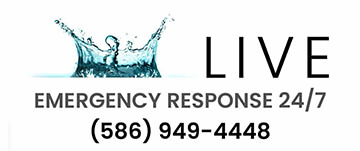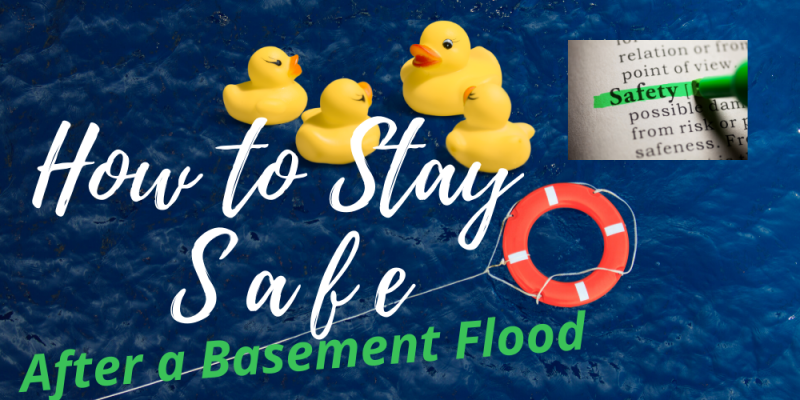How To Stay Safe After A Basement Flood
Staying Safe During A Flood
It’s every homeowner’s worst nightmare. Flooded homes are the second most common insurance claims made by homeowners every year. Over a 20-year period the chance that you will experience water damage to your home in some shape or form is almost 100 percent guaranteed. So, what do you need to know about how to stay safe after a basement flood? Let us review what you should do immediately after discovering a flooded basement, and the different ways flooded homes can be dangerous to you and your family.
First Things First
The first thing you should always do when you discover a flood in your basement or anywhere in your home is to call a local reputable highly rated water restoration company. A good restoration company will be able to walk you through all of these steps quickly and coherently in the event you do not have this blog handy when you need it. The flood technician on the line will be able to inform you of the potential dangers of the flood you are dealing with and what to expect in the days to come.
Never Enter A Flooded Basement
Electrical Dangers In Flooded Environments
Flooded basement can be danger zones in more ways than just one. While some flood jobs can be hazardous to your health, a newly flooded basement can be infused with electricity from wet appliances or shredded power lines. If your homes electrical box is located on the first floor of your home, you may shut down power to your home if you absolutely have to enter your basement but it is always safer to allow the professionals at Action Extraction make sure your basement is safe to enter.
There is never a good plan for restoration if electrical concerns are not fully addressed. Homeowners insurance will always pay for the cost of an electrician to make sure all is safe. There is no way to stay safe after a basement flood if you get electrocuted because you didn’t make sure it was safe.
Chemical And Organic Dangers In Flood Water
When it comes to basement floods you may also be dealing with highly toxic and contaminated water. By walking into a sewage water backup environment, you are exposing yourself to millions of potential viruses and bacteria, as well as likely transferring that contamination throughout your home when you exit your basement. To be able to stay safe after a basement flood yo need to be aware of the dangers you do not see. Germs, molds and other potentially harmful microorganisms abound in sewer water and ground water, so even though you cannot see them, they are a real and present danger.
It is highly recommended to call a professional restoration company and ask what to do after a sewer backup.
The professional restorer will use haz-mat suits and boot coverings, as well as respirators and gloves for their own protection and disposable floor coverings to protect the inside of your home as well.
Remove The Water – The Sooner The Better
Once the water has been deemed safe to venture into, it is important to go around the basement and evaluate the damage to contents and building material. Your flood team should be actively removing water from your basement using extraction machines or, if the water level is high enough, submersible sump pumps. We have personally worked on flooded basement projects with water up to 6 feet high requiring the use of submersible pumps over hours and hours. When the standing water is finally removed from your home, all electronics should be either disposed of or evaluated by a certified electronic restoration crew to determine whether or not that electrical item will become a hazard. Often times water damage done to electronics only reveal themselves months and years later.
Many homeowners place personnel contents in plastic totes to protect valuables from a flooded basement in the event that floor drains backup. While this is a great way to prevent water from coming into contact with water, it is important to still evaluate the items in the tote. Because they are plastic they may acquire a crack allowing water to intrude and affect the contents. If they are wet remove them from the storage tote and clean as necessary.
Create A Drying Protocol
Behind every great victory there is a great strategy. To stay safe after a basement flood you must have a great strategy. Adopting structural drying techniques and exposure principles will be the most important step you need to take to keep you and your family safe. In the event of a flooded basement it is best to work with a certified water restoration company to make sure your home is dried quickly and safely. Fungi of all types require water, food and oxygen to grow and thrive. Your home is the equivalent of a Vegas buffet when it comes to food sources for mold to feast and multiply on.
Any cellulose item can support tens of thousands of mold spores when introduced to water and time. This can be drywall, certain types of clothing, cardboard boxes and any other paper product or organic materials like food stuffs. It is imperative that you have a structural drying protocol in place and in motion within 48 to 72 hours of water introduction into your home.
By exposing any saturated building material to rapid air flow using fans and regulating the relative humidity using dehumidifiers, most flooded homes can be dried safely and quickly, typically 3 to 5 days. If saturated building materials are left to their own devices, after 72 hours mold colonies will begin to form and spread across any food sources they can find, eating and reproducing unabated until their water source is dried up.
What To When You Encounter Mold
Mold growth in a home is always an unwelcome sight. Whether due to untreated water damage, or secondary growth due to high humidity, it’s important that you know how to stay safe after a basement flood. When possible, the safest remedy to mold growth is removal. The area in which mold is found should immediately be sealed off from the rest of the home and put under negative air.
To do this, flood technicians will use a negative air machine to force air out of a home using plastic venting, while closing the rest of the home off using thick plastic and taping off any air return vents that reside in the room. This creates an environment in which mold spores are unable to shed from the surface of whatever building material they are found on to continue growing and protects your home from future mold issues.
All contaminated material should be contained, removed, and double bagged. In areas in which removal is impossible or unreasonable, a cleaning agent and an oil-based sealant may be used to entrap mold spores and prevent their ability to spread. The most important tool flood technicians have in regard to mold is to dry building material before it has the ability to grow in the first place.
During The Restoration Process
A flood job can sometimes be an extremely messy ordeal. Even the most professional crews may leave items stacked in the middle of rooms to allow for focused air flow on the walls. Hardwood floors that have been removed leave nails and tacks that are numerous and difficult to remove for even the most seasoned flood technicians. It is important while walking through these areas of your home while it is under repair that you make sure to wear shoes and be mindful of the various extension cords and obstructions you may come across.
While all of our equipment is safe and reliable for use, little fingers can find their way into fans, so it’s important to make sure children are always supervised when it comes to homes under repair. Carpeting on stairwells is typically left to be removed before new carpet is installed to prevent a slippery hazard when travelling the stairwell. If the carpet is deemed safe and capable of being salvageable once everything is completely dried, a thorough carpet cleaning will be necessary.
All flood work we do at Action Extraction is done with the mind set of your continued safety well after we leave you home, but these are some things to be cautious of while your home is being tended to.
The Safest Flood
The safest flood is no flood at all. Keeping your home dry by preventing water damage in the first place is the best thing you can do to keep your family healthy. By using a vigilant eye on your water using appliances, you can head off potential disasters before they ever develop. Maintaining your sewer lines through biannual plumber visits will help to alert you to potential backup problems and keep your sewer lines clean and clear. Turning off your outside water spigots during the winter and maintaining insulation in your basement will help to prevent frozen copper lines leading to freshwater water damage. Additionally this will assure you avoid water damage from a sprinkler system that could freeze burst and intrude into your basement.
Making sure your sump pump is working and well maintained will help to ensure your pump is in prime working order for when its service is needed most. The most common type of basement flooding in Macomb County is from a failed sump pump. If you intermittently apply a penetrating oil to all the interactive metal components, this will keep them from corroding and freezing up when called upon to work.
Checking outside downspouts for pooling against your home is another easy way to prevent water damage in your home. While all of these tips and tricks won’t absolutely prevent water from finding it’s way into your home in any scenario, they will at least give you a firm foundation on which to secure the long term health of your property.
What To Do Now?
Floods are dangerous to not just your homes structural health but also to your health and the health of your family. While water is necessary for all life forms, it is one of the most destructive forces found in nature. Remember, if you find intrusive water in your home, in any form, your most important step to stay safe after a basement flood is to call a certified and highly rated emergency water restoration company like Action Extraction. Our professionals are highly trained in restoration and will be glad to help guide you through what can often be a stressful and overwhelming situation.
Check out our article on the 6 steps to choose the best water cleanup company.
While flooding in your home is never ideal, it is important that water damage be treated seriously and by well trained professionals with intelligent, safe and efficient methods of structural drying in their repertoire. The professionals at Action Extraction have the knowledge and technical ability to turn any flood disaster into a safe and dry environment ready to be repaired. We hope that you’ll consider Action Extraction for all of your flooded basement needs, now and in the future!




